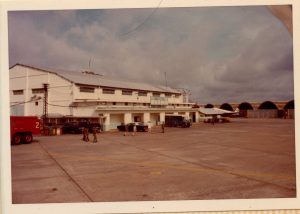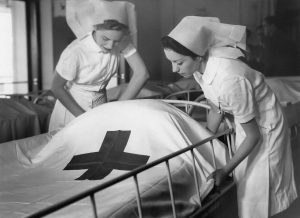In Memoriam
World War II Army Flight Nurses
Jenevieve (Jenny) Boyle Silk, who died in June 2017, was the last living of the 25 World War II US Army flight nurses whom I interviewed in 1986 for what became Beyond the Call of Duty: Army Flight Nursing in World War II. I clearly remember each of my interviews with these remarkable women and still can picture them and hear their voices when I think of them.
Twenty of these interviews are now digitized and available as audio recordings on the Imperial War Museum website. Access the interviews here:
My short remembrances are in the order in which I interviewed these former flight nurses.
Miranda (Randy) Rast Weinrich (1914–2005)
803 MAES, China-Burma-India
Randy (Miranda) Weinrich née RAST (Saint Anthony Mercy Hospital School of Nursing, Pocatello, Idaho, 1936) worked for a year as a private duty nurse after earning her nursing diploma, then in central supply at Mercy Hospital, Denver for over three years. After war was declared, she entered the army on 15 April 1942, “because,” as she said, “my brother was in the service,” and she thought if he got hurt, she “would want to take care of him.” Her first duty assignment was as a staff nurse at the AAF station hospital at Will Rogers Field in Oklahoma City. While there, Randy applied for the flight nurse program when the opportunity arose. After successfully passing the physical exam, Randy was sent to Bowman Field, KY, where she stayed for about nine months, working on the staff of the School of Air Evacuation for four months while waiting for a slot in the flight nurse course, from which she graduated on 14 May 1943. Assigned to the 803 MAES, her squadron remained at Bowman Field another four months in active training before shipping overseas to the China-Burma-India Theatre (CBI). Randy recalled daily marching, firearms training, and hikes with full gear.
On arrival in the CBI, three of the four flights in the squadron were billeted at Chabua, India. The fourth flight, to which Randy was assigned, was sent to China. The six nurses in Randy’s flight were scattered all over China; Randy was stationed at Kunming. In theory, the other nurses in China would bring patients to Kunming, and Randy then would fly with the patients over the Hump – the eastern end of the Himalayan Mountains. In reality, however, there was not much flying because of limited gas and supplies and unpredictable weather over the Hump. Randy flew “on demand,” and when not flying, she worked in the AAF dispensary at Kunming.
Randy was a flight nurse for fourteen months. She didn’t know what to expect, but liked it. She thought flight nursing unique for its time, for men could be wounded and in a matter of hours would be back at a hospital. It did wonders for the solders’ morale, she said. When asked what helped her the most during her time as a flight nurse in World War II, Randy answered, “My religious background.” For one thing, maybe things aren’t really as bad as they are on the surface, she explained. Tomorrow they’re not as bad as they seemed yesterday. “I did the best I could, and then I left it in somebody else’s hands.”
Interviewed 19 Jun 1986, Hemet, CA
Learn more about my interview with Randy on the Blog for 24 Sep 2016.
To be continued



